Research Article 
 Creative Commons, CC-BY
Creative Commons, CC-BY
The Restitution of the Body Posture Values in the Sagittal and Transversal Plane after Carrying a Schoolbag on the Chest and its Correlations with Physical Activity Among 7-Year-Old Children of Both Sexes
*Corresponding author: Mirosław Mrozkowiak, Physiotherapy Clinic AKTON, Poznań, Poland.
Received: May 18, 2023; Published: May 31, 2023
DOI: 10.34297/AJBSR.2023.19.002541
Summary
Introduction: The analysis of the student’s environment is a set of stressors in the field of human ecology.
Material and Method: The body posture tests were carried out in a group of 65 students aged 7 years, using the moiré projection method in 4 positions: 1st-habitual posture, 2nd-posture after a-10-minute of axial symmetrical loading, 3rd-one minute after the load removal, 4th-two minutes after the load removal. Physical fitness was measured with the Sekita test, completed by an endurance test.
Results: The significance of differences between 1st and 3rd, 1st and 4th, 2nd and 3rd as well as 3rd and 4th measurement were analysed to determine the restitution of the features values after loading and their correlation with physical fitness.
Conclusions:
a) After the load removal of carrying school supplies from the chest, there was an incomplete restitution of almost all values of the diagnosed posture features after the first and second minute.
b) The relationships between the examined determinants of physical fitness and the restitution of the values of posture features are much more frequent among boys than girls. The most frequent correlation was between endurance and speed among boys, whereby agility, strength and overall fitness appeared among girls. Restitution of the values of posture features that most often showed relationships with physical fitness features among boys were asymmetry of the pelvis tilts to the left (KSM-) in the transversal plane, and convexity of the lower angles of the shoulder blades, where the left one was more convex (UB-), and, asymmetry of verticality of the torso bend in the sagittal plane (KPT-) and the sum of the piecemeal angles (Delta), among girls.
c) There should be actions taken to promote a healthy lifestyle for children, including physical education.
Keywords: Children’s health, Moiré topography, Physical fitness, Postural asymmetry factor
Introduction
Regulation of the Minister of National Education of 25th August 2009 changing the regulation on safety and hygiene in public and private schools and institutions (Journal of Laws No. 139, item 1130) regulates the permissible weight of a schoolbag and obliges the school to allocate cabinets. Polish legislation does not regulate the maximum weight of a schoolbag for school children and youth, but it is assumed that the ratio of the weight of the schoolbag to the weight of the student’s body should hesitate from 10% to 15%. The Chief Sanitary Inspectorate established two standards-a low standard (10%) and a high standard (15%) for the purposes of the analysis. Therefore, the State Sanitary and Epidemiological Station in Ostrów Mazowiecka, in accordance with the guidelines of the Chief Sanitary Inspectorate, carried out an assessment of the load on students with schoolbags in two schools. A total of 371 students were assessed. The study included the measurement of the student’s body weight and the weight of the schoolbag with its content. The analysis of the research results showed that 63 primary school students and 117 junior high school students wore a satchel or a backpack with a weight of less than 10%, which constituted 48.5% of all weighed backpacks. The ratio of the backpack weight to the body weight in the range of 10-15% was found in 37.5% of students. Above the norm, i.e., when the ratio of the backpack weight to body weight was higher than 15%, it was found in 14% of all respondents.
The evaluation process included the assessment of the school’s providing students with the possibility of leaving some textbooks and school supplies. This obligation was imposed by the ordinance of the Minister of National Education of 25th August 2009 amending the regulations on safety and hygiene in public and private schools and institutions (Journal of Laws No. 139, item 1130). Schools, which made the assessment of the load on students with backpacks complied with this obligation [1]. The research by Jakubowicz-Bryx shows that, in accordance with the recommendations of the Minister of National Education, in order to unweight the school bag and care for the proper somatic development of a student, it is possible to leave at least some textbooks and accessories in a school building. In the study group, school principals and early school education teachers created a place for school supplies in classrooms in the form of cabinets, shelves, drawers, and separate shelves. After a few months, it was shown that 97% of respondents leave their textbooks and school supplies in lockers, 94% of respondents keep them on shelves, 76% in drawers, and 71% on separate shelves. In order to prevent disturbances in the statics of body posture, in the study group, educators paid attention to a suitably profiled satchel with a stiffened back support with the lower part convex, which was confirmed by 94% of respondents. It was also confirmed in the case of a soft, adjustable, and wide harness-91%, the content of a school bag-86%, carrying a school bag on both shoulders-86% and having pockets that allow even distribution of the weight-79% [2].
The problem of the impact of the weight of school supplies has been dealt with by, inter alia [3-5]. The conducted literature review showed that Mrozkowiak, et al. [6-8] and Romanowska [9] dealt with the problem of restitution of the values of posture features after loading. Other authors like Bajorek, et al. [10], Barczyk-Pawelec, et al. [11], Dolata Łubkowska, et al. [12], Drzał Grabiec, et al. [13], Grabara, et al. [14,15], Słoniewski, et al. [16], Ślężyński, et al. [17], Utake, et al. [18], Wojtków, et al. [19], Zeyland Malawka [20], Żurek, et al. [21] mainly studied the influence of specific physical work on selected values of posture features. There is a general conclusion from the above-mentioned works that every physical effort modulates the course of posturogenesis, especially intensive. sports training. It is the body posture that becomes typical of the sports discipline practiced. It will be different for a gymnast, swimmer, athlete, rider, shooter, or archer.
The author’s interest in the issues stems from the persistently high percentage of disorders of the body posture of students from the oldest preschool group and 1st-3rd grades of primary school, the constantly proclaimed opinion about the negative impact of the way of carrying school supplies on body postures, and the lack of clear recommendations about the optimal weight and contraindications against the negative way of carrying these utensils. The general objective of the implemented research programme is an attempt to determine the impact of weight of carried school supplies in the following way: obliquely on the right shoulder or left shoulder and at the heteronymous hip, on the left or right shoulder, on the back, on the chest, on the back and chest, pulled with the left or right hand.
The aim of the research was to demonstrate the restitution of the value of selected posture features in the sagittal and transversal planes after removing the weight of school supplies carried on the back and its relationship with physical fitness.
Research Material
The study involved children from randomly selected kindergartens in the West Pomeranian and Greater Poland voivodeships. Body posture defects and disturbances were not criterions that excluded participation in the research programme. The division of the respondents into those from rural and urban environments was abandoned since this feature would never determine the homogeneity of the group and the cultural and economic blurring boundary of both environments. The respondent was qualified to the programme according to the following scheme: if the respondent was 6years, 6months and 1day old and under 7years, he was included in the 7-year-old age group. This allowed to use the previously developed normative ranges appropriate for this age and sex category, diagnosing the quality of the body posture from the test day [22]. In total, 65 students participated in the programme, of which 53.84% (35 people) were girls and 46.15% boys (30 people).
Research Method
Before the measurements started, the children were instructed in order to avoid the stress associated with the research procedure and the people responsible for it. A preschool teacher’s assistant of the study group was always present during the research, which was to ensure the emotional stability of the children. Measurements were carried out in accordance with the developed procedure, always with the same tools, under the same conditions and by the same people. The children were also encouraged to keep the anthropometric points marked with a marker on the skin, which was to effectively eliminate deviations in their repeated indication. The research was carried out by a physiotherapist with a 20-year-old experience in the diagnosis of body posture using the moiré projection method.
Overall Physical Fitness
The Wroclaw Physical Fitness Test for 3-7-year-old children was used to diagnose physical fitness [23]. According to the author, the test is of a high degree of reliability and is adequate in terms of discriminatory ability and degree of difficulty [24]. The proposed test, which significantly increased the motivation to exercise in the presence of parents, consists of four tests implemented as a part of the Sports Day: agility (pendulous run over 4x5m with carrying blocks), power (standing long jump), speed (running at 25m), and force (a 1kg ball both-hands-throw from the head). The author modified the test by a fifth attempt-endurance. Starting position- high starting stance. Movement-run over 300m. The running time from the start to finish was assessed and converted into points depending on the result and gender. If the child did not finish the race, they got a score of “0”. The run took place on a recreational path with a hardened surface, remaining all safety rules [25]. Visualization [26].
Body Posture
The applied method using the projection moire phenomenon determines the value of several dozen features describing the body posture. It makes it possible to determine the influence of various methods of carrying a bag with school supplies on body posture, restitution of the value of features after removing the load, and the importance of physical fitness in disorders and restitution of the value of the diagnosed features [22,27,28].
A custom-designed diagnostic frame was provided to ballast the body posture (utility model no. W.125734). The presence of an assistant during the examination was dictated by the need to minimize the time from the load removal to the second registration of the value of the posture features. Every effort has been made to ensure that the custom-designed loaded frame was individually adapted to the type of child’s body structure. The adopted 10-minute load time was the average time to walk from the place of residence given in the questionnaire completed by the parents [29]. However, the load was determined by averaging the weight of school supplies to 4kg carried by first-class children from a randomly selected primary school. Selected features of body posture were measured in 4 positions (Pictures 1,2). The first position-habitual position, Picture 1. Second position-posture after 10 minutes of asymmetric loading on the back (in the last 5 seconds), Picture 2. Third position-posture one minute after the load removal Picture 1. Fourth position-posture two minutes after the load removal, Picture 1. The load was supposed to imitate the way of carrying school supplies. The subject could move freely. This was in line with the previous results of Mrozkowiak’s research, which showed that after this time, the values of posture features could be at the starting point [8]. It could be assumed that it was appropriate and relatively constant for each student when diagnosing the habitual posture on the first day of the research programme. However, in order to maintain the reliability of the research, it was assumed that any inconsistency with the value of the features from the first stage of the measurements may affect the final test result. Therefore, before pulling the load up destined by the procedure, the features of the habitual posture were always determined as a reference for the subsequent dynamic changes of the diagnosed features. The height and weight of the children as well as the weight of the carried school supplies were measured with a medical balance before the first day of the tests.
The measurement site for the value of selected features of the body posture consists of a computer and a card, a programme, a monitor and a printer, a projection-receiving device with a camera for measuring selected parameters of the pelvis-spine syndrome. The place of the subject and the camera were oriented spatially in accordance with the levels on the camera and in relation to the line of the child’s toes. It is possible to obtain a spatial image thanks to the projection of lines on the child’s back with strictly defined parameters, which falling on the body are distorted depending on the configuration of its surface. Thanks to the use of the lens, the image of the examined person is taken by a special optical system with a camera, and then transferred to the computer monitor. Line image distortions recorded in the computer memory are processed by a numerical algorithm into a contour map of the tested surface. The obtained image of the back surface enables a multi-layered interpretation of the body posture. It is possible to determine the size of the angular and linear features describing the pelvis and physiological curvatures in the sagittal and transversal planes apart from the assessment of the torso asymmetry in the frontal plane [30].
The following test procedure was developed in order to minimize the risk of making mistakes in the measurements of selected posture features [22]:
a) Habitual posture of the subject against the background of a white, lightly illuminated sheet: free, unforced posture, with feet slightly apart, knee and hip joints in extension, arms hanging along the body and eyes looking straight ahead, with the back to the camera at 2.5 meters, toes at a perpendicular line to the camera axis.
b) Marking points on the back skin of the examined: the top of the spinous process of the last Cervical Vertebra (C7), the spinous process being the top of the Thoracic Kyphosis (KP), the spinous process being the top of the Lumbar Lordosis (LL), the transition place from thoracic kyphosis to lumbar lordosis (PL), the lower angles of the scapulae (Łl and Łp), the posterior upper iliac spines (Ml and Mp), and the S1 vertebra. A white necklace was put on the subject’s neck to clearly mark the B1 and B3 points (Picture 1). Long hair up to reveal C7 point.
c) The digital image of the back was recorded in the computer memory in each of the tested positions from the middle phase of free exhalation after entering the necessary data about the examined person (name and surname, year of birth, weight and body height, comments about the condition of the knees and heels, chest, past injuries, surgical procedures, diseases of the musculoskeletal system, gait, etc.).
d) Processing of the recorded images takes place without the participation of the subject.
e) The value of the features describing the body posture spatially are printed after saving the mathematical characteristics of the photos in the computer memory (Figure 1).
Subject of Research
The Wrocław fitness test allowed to measure the strength, power, speed and agility of preschool children. The author modified Sekita’s test for a test of endurance. Definitions of the tested physical and complex motor skills are generally available in the literature [24]. The applied method, which uses the phenomenon of the projection moiré, defines several dozen features describing the body posture. For statistical analysis, 19 angular and linear features of the spine, pelvis and torso in the frontal plane as well as body weight and height were selected. It was guided by the need of the most reliable and spatially complete look at the child’s body posture, which allowed to fully identify the measured discriminants (Table 1) (Figures 2-4).
Research Questions and Hypotheses
The following research questions arise from the aim of the research:
a) Will the child unweighting in the adopted way of carrying the schoolbag significantly affecting the statics of body posture in the frontal plane, cause a sex-dependent restitution of the values of the features?
b) Will physical fitness show significant and sex-dependent relationships with the values of restitution of posture features after the first and second minute after the load removal?
Our own research results and the analysis of the available literature allow us to believe that:
a) The adopted way of carrying the school supplies, significantly affecting the statics of body posture in the frontal plane, will cause incomplete and gender-independent restitution of the values of the examined features.
b) Physical fitness will show significant and gender-dependent relationships with the restitution of the values of the posture features after the first and second minute after the load removal.
Statistical Methods
It was assumed that the standard deviation is a measure of differentiation. The higher it is in relation to the mean, the greater the variation of results is in each group. There was no reference to it in the description of the results, but in analytical practice its application was treated as a concomitant measure of the arithmetic mean. In the used analysis, the reference to SD was abandoned. These were only given in the introductory tables (where M was also given) as a formality. SD was a concomitant measure of M. It was also assumed that the value of SD in the performed studies was not interpreted in any way, especially if the analysis was based on non-parametric tests and median (Me), but not the mean (M). Therefore, SD and M were finally removed in the initial analyzes to concentrate the tables and leave there only necessary issues for the research. Standard deviation is a concomitant measure of the arithmetic mean and therefore it is not valid to put it next to the median.
The analysis of the study results was performed using the IBM SPSS Statistics 26 programme. At the initial stage, the Shapiro-Wilk and Kołmogorow-Smirnow tests were used to ensure if the distributions of the analyzed variables were consistent with the normal distribution. For most of the variables, there were statistically significant deviations from the normal distribution at the level of p <0.05. Therefore, it was decided to use tests and non-parametric coefficients in the statistical analysis. The Wilcoxon rank test was used to determine whether there was a statistically significant difference (change) between two measurements (in the same group) of the quotient variable whose distribution was significantly different from the normal one. The following symbols were used in the tables: M-arithmetic mean, Me-median, SD-standard deviation, Z-Wilcoxon test statistic, “p”-significance of the Wilcoxon test. The level of significance was set at p <0.05, marked as *, and additionally, the significance level p <0.01, marked as **. Thus, if p <0.05 or p <0.01, then the difference between the measurements was statistically significant. The Spearman’s rho correlation coefficient was used to determine whether there were statistically significant correlations between the variables measured at the quotient level, which distribution significantly differed from the normal one. The level of statistical significance was set at p <0.05, marked as *, and additionally, the level of significance p <0.01, marked as **. Thus, if p <0.05 or p <0.01, then the correlation between the variables was statistically significant. If the correlation was statistically significant at the level of p <0.05, then the correlation coefficient rho should be interpreted. It could take values from -1 to +1. The more distant it was from 0, and the closer it was to -1 or +1, so the correlation was stronger. Negative values meant that as the value of one variable increased, the value of the other variable decreased. On the other hand, positive values indicated that as the value of one variable increased, the value of the other variable increased, too. In the individual tables of correlation, only the variables were considered (in the rows), which at least one statistically significant result was recorded for Individual values of posture features are expressed in different sizes and ranges, so it is not possible to calculate the average difference for all these variables between the two measurements. An analysis performed in such a way would distort the results and make the variables, in which the quantities are higher of greater importance, and the variables, in which the quantities were lower of less importance. Therefore, the correlation between the averaged difference in the value of features between the measurements and physical fitness was made separately for girls and boys, using absolute values, i.e., the calculations did not use exact numerical values concerning the differences, but the ratio of the difference to the initial value. This approach makes the variables not to be overrepresented or underrepresented in the average result.
The analysis included a comparison of the value of posture features between 1st and 3rd, 1st and 4th, 2nd and 3rd and 3rd and 4th with the measurement of the school bag carried on the back. This was to show the restitution (full or incomplete) of changes in the analyzed posture features in the adopted way of carrying school supplies. To concentrate the results of the analysis as much as possible, the tables include only the medians, and the significance of the Wilcoxon test results.
The analysis of the correlation between the results of physical fitness tests and the difference between 2nd and 3rd, 3rd and 4th, 1st and 3rd and 1st and 4th measurements separately for boys and girls was also performed. Only those individuals, who had both physical fitness tests and appropriate body posture measurements were considered. To concentrate the results of the analysis as much as possible, only the correlation coefficients (rho) were included in the tables. Correlations statistically significant at the level of p <0.01 are marked **, and correlations statistically significant at the level of p <0.05 are marked *. The individual tables include only those variables (in the rows), which at least one statistically significant result was recorded for.
Obtained Results
In total, the research carried out in a group of 65 people of both sexes aged 7 years allowed to register 5,395 values of features describing body posture in habitual posture and dynamic positions, body weight and height, and physical fitness.
Average body weight (MC) was as follows: among girls 24.46kg, body height (Wc) 123.87, and among boys: 24.56kg and 123cm, respectively. All children had a slender body type according to the Rohrer Weight and Growth Index [31].
Information was also obtained through a survey conducted among 65 parents of children reported to the research project [29].
The analysis of the results of the applied Wrocław fitness test and the endurance diagnostic trial showed that the tested group of children represented a sufficient level of physical fitness, assuming grading: insufficient, sufficient, good, very good. This level was significantly lower than the values obtained in the measurements of other authors from 2006, 1996, 1972 and 1967 [32-34]. The phenomenon of sexual dimorphism in the studied group of 7-year-olds of both sexes was not confirmed.
When analyzing the obtained results of measurements in carrying a schoolbag on the chest by boys only, the Wilcoxon rank test showed a statistically significant difference between 3rd and 1st, 2nd and 3rd, and 3rd and 4th measurements in terms of all analyzed variables. The exception is the differences between 1st and 3rd, 1st and 4th, 2nd and 3rd, as well as 3rd and 4th measurement in the case of Alfa variables, which are insignificantly static (Table 2).
Considering girls only, the Wilcoxon rank test showed a statistically significant difference between 3rd and 1st, 2nd and 3rd, and 3rd and 4th measurements in terms of all analyzed variables. The exception is the differences between 3rd and 4th measurement in the case of Alfa variables, and between 1st and 4th in the case of Beta, which are insignificantly static (Table 3).

Table 2: The restitution of the values of body posture features in sagittal and transversal plane between 2nd and 3rd, and 3rd and 4th measurement after the chest loading among boys.
*Source: Own research.
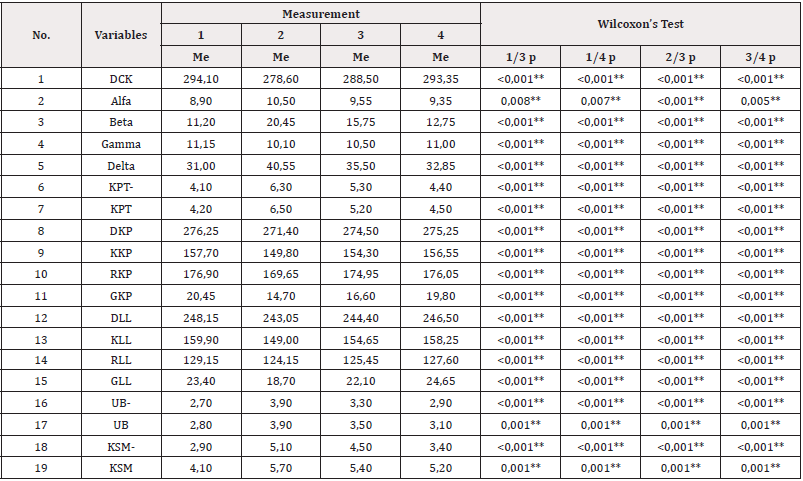
Table 3: The restitution of the values of body posture features in sagittal and transversal plane between 2nd and 3rd, and 3rd and 4th measurement after the chest loading among girls.
*Source: Own research.
Considering the differences between the 2nd and 3rd measurement among boys, it turned out that the greater the endurance, the smaller the asymmetries of the lower angles of the shoulder blades, where the right shoulder blade is more convex (UB+), but the greater differences in the size of the thoracic kyphosis angles (KKP) and the greater asymmetries of the pelvis tilt to the left (KSM-). The faster the speed, the smaller the asymmetry of the pelvis tilt to the left (KSM-), but the greater the strength, force, overall fitness and agility, the greater the asymmetry of the pelvis tilt to the left (KSM- ). The greater the overall fitness, the greater the differences in the total length of the spine (DCK). Analyzing the differences between the 3rd and 4th measurement, it turned out that the greater the endurance, the smaller the differences in the inclination angles of the thoracolumbar section (Beta), the sum of the partial angles (Delta), the angles of thoracic kyphosis (KKP) and lumbar lordosis (KLL), but the smaller the asymmetries the angles of the lower shoulder blades, where the left is more convex (UB-), the pelvis tilt to the left (KSM-) or right (KSM+). The greater the speed, the smaller the differences in the total length of the spine (DCK), the angles of the thoracolumbar segment (Beta), the sum of the partial angles (Delta), the angles of thoracic kyphosis (KKP) and lumbar lordosis (KLL), but the greater the asymmetries of the angles of the lower shoulder blades where the left is more convex (UB-) and the pelvis tilt to the left (KSM-). The greater the strength, the smaller the asymmetries of the angles of the lower shoulder blades, where the left one is more convex (UB-), and the pelvis tilt to the left (KSM-), but the greater the differences in the depth of thoracic kyphosis (GKP). The greater the force the smaller the asymmetry of the pelvis tilt to the left (KSM-), but the greater the difference in the length of the lumbar lordosis (DLL). The greater the agility, the smaller the asymmetries of the angles of the lower shoulder blades, where the left one is more convex (UB-), and the pelvis tilt to the left (KSM-), but the greater the differences in the height of the thoracic kyphosis (RKP), the greater the asymmetry of the angles of the lower shoulder blades, where the right it is more convex (UB+). The greater the overall fitness, the smaller the asymmetries of the angles of the lower shoulder blades, where the left one is more convex (UB-) and the pelvis tilt to the left (KSM-), but the greater the asymmetries of the angles of the lower shoulder blades, where the right one is more convex (UB+) (Table 4).

Table 4: Correlation of physical fitness and the restitution between 2nd and 3rd, and 3rd and 4th measurement of body posture features in sagittal and transversal plane after the chest loading among boys.
*Source: Own research.
Considering the differences between the 1st and the 3rd measurement, it turned out that the greater the endurance, the smaller the differences in the inclination angles of the thoracolumbar segment (Beta), the sum of the partial angles (Delta), thoracic kyphosis (KKP), length (DLL) and the angles of lumbar lordosis (KLL) and smaller asymmetries of the pelvis tilt to the left (KSM-), but larger asymmetries of the angles of the lower shoulder blades, where the left one is more convex (UB-). The greater the speed, the smaller the asymmetries of the angles of the lower shoulder blades, where the left one is more convex (UB-), but the larger the pelvis tilt to the left (KSM-). The greater the strength, the smaller the asymmetry of the pelvis tilt to the left (KSM-), and the greater the angles of the lower shoulder blades, where the left one is more convex (UB-). The greater the power, the smaller the asymmetry of the pelvis tilt to the left (KSM-), and the greater the angles of the lower shoulder blades, where the left one is more convex (UB-). The greater the agility, the smaller the asymmetry of the pelvis tilt to the left (KSM-), and the greater the asymmetry of the angles of the lower shoulder blades, where the left one is more convex (UB-). The greater the overall fitness, the smaller the asymmetry of the pelvis tilt to the left (KSM-), but the greater the angles of the lower shoulder blades, where the left one is more convex (UB-).
Analyzing the differences between the 1st and the 4th measurement, it turned out that the greater the endurance, the smaller the differences in the length of the lumbar lordosis (DLL), the smaller the asymmetries of the verticality of the trunk extension (KPT +), the pelvis tilt to the left (KSM-), but the greater asymmetries of the angles of the lower shoulder blades, where the left one is more convex (UB-). The greater the speed, the smaller the asymmetries of the verticality of the trunk extension (KPT +) and the angles of the lower shoulder blades, where the left one is more convex (UB-), but the greater the differences in the sums of partial angles (Delta), thoracic kyphosis angles (KKP) and lumbar lordosis (KLL) and greater asymmetries of pelvic tilt to the left (KSM-). The greater the strength, the smaller the asymmetry of the pelvis tilt to the left (KSM-), and the greater the angles of the lower shoulder blades, where the left one is more convex (UB-). The greater the force, the smaller the asymmetry of the pelvis tilt to the left (KSM-), and the greater the angles of the lower shoulder blades, where the left one is more convex (UB-). The greater the agility, the smaller the asymmetry of the pelvis tilt to the left (KSM-). The greater the overall fitness, the smaller the differences in the inclination angles of the of the upper thoracic segment (Gamma), the smaller the asymmetries of the verticality of the torso extension (KPT +) and the asymmetries of the pelvis tilt to the left (KSM-), but the greater the angles of the lower shoulder blades, where the left one is more convex (UB-) (Table 5).

Table 5: Correlation of physical fitness and the restitution between 1st and 3rd, and 1st and 4th measurement of body posture features in sagittal and transversal plane after the chest loading among boys.
*Source: Own research.
Considering the girls and the differences between the 2nd and 3rd measurement in carrying on the chest, it turned out that the greater the endurance, speed, strength, agility and overall fitness, the smaller the asymmetry of the verticality of the torso extension (KPT-). The greater the force, the greater the variation in length of the lumbar lordosis (DLL). Analyzing the differences between the 3rd and 4th measurement, it turned out that the greater the endurance, the smaller the asymmetry of the pelvis tilt to the left (KSM-). The greater the force, the smaller the asymmetries of the verticality of the trunk extension (KPT-) and the smaller differences in the depth of thoracic kyphosis (GKP) (Table 6).

Table 6: Correlation of physical fitness and the restitution between 2nd and 3rd, and 3rd and 4th measurement of body posture features in sagittal and transversal plane after the chest loading among girls..
*Source: Own research.
Considering the differences between the 1st and 3rd measurement, it turned out that the greater the endurance, the smaller the asymmetry of the pelvis tilt to the left (KSM-). The greater the force, the smaller the asymmetry of the verticality of the trunk extention (KPT-) and the smaller the difference in length of the lumbar lordosis (DLL). The greater the agility, the smaller the asymmetry of the pelvic tilt to the right (KSM+). Considering the differences between the 1st and 4th measurement, it turned out that the greater the endurance, the smaller the differences in the length of thoracic kyphosis (DKP) and the greater the height of lumbar lordosis (RLL). The greater the speed, the greater the difference in the sum of the partial angles (Delta). The greater the strength, the greater the differences in the sums of the partial angles (Delta), thoracic kyphosis (KKP) and lumbar lordosis (KLL) angles. The greater the power, the smaller the variation in length of lumbar lordosis (DLL). The greater the agility, the smaller the differences in the height of the thoracic kyphosis (RKP), and the greater the sum of the partial angles (Delta), the angles of the thoracic kyphosis (KKP) and lumbar lordosis (KLL), and the greater the asymmetry of the verticality of the trunk extension (KPT+). The greater the overall fitness, the greater the differences in the sums of partial angles (Delta), thoracic kyphosis (KKP) angles and lumbar lordosis (KLL) (Table 7).
Discussion
A review of the literature on the subject revealed only a few works on the restitution of significantly changed features of body posture under the influence of load of the school supplies carried on the chest by a 7-year-old child. The authors focused more on exploring the consequences of loading the spine with school supplies carried on one of the shoulders or back, or on the effects of various weight of the supplies themselves [3-5]. The reasons can be found in the lack of tools that measurably diagnose the features of body posture and the way of placing the load imitating a school backpack so that it could be objectively measured., It should be believed that the undertaken research is one of the first attempts to determine the restitution of static posture disorders after the assumed load removal, and to draw attention not only to the consequences of asymmetric loading, but also to the time of returning to the habitual posture. Mrozkowiak conducted a study in a group of 45girls aged 12years on the influence of axial load on body posture in the frontal and transversal plane. The diagnostics included the measurement of selected features in the habitual posture without the load and at 1-minute intervals in a posture with a 6-kilogram load placed on the shoulders of the student.
The subject could move freely. The analysis of the obtained results showed that the changes in the values of the diagnosed features were insignificant, and the restitution of the changed values appeared after the second minute of the load removal [8]. The analysis of other research results carried out by this author on the restitution of the values of posture features in the frontal, transversal and sagittal plane in carrying with the left or right hand drag method, showed that the restitution of the values of any of the analyzed features was not complete after the first and second minutes after the carrying has stopped. This proves insufficient physical fitness and slower restitution [35]. The survey conducted by Mrozkowiak among parents of 7-year-old children shows that parents most often declare that they know their children’s health condition. They believe that the first grader will wear a four-kilogram school bag on their back, learn traditionally (without a tablet) and spend about 2hours improving their physical fitness [30]. According to the author, the accepted lifestyle does not fully support the development of physical fitness and the prevention of static posture disorders.
In Dobosz’s research on the effects of overloading the body posture with a backpack, a habitual body posture without a load was adopted as a reference point. At the moment of carrying the backpack in the traditional way, with a load of 5% of body weight, the COP shifted backwards, which caused a strong compensatory reaction leading to its displacement forward. Although, it is not clear from statistical calculations, this trend occurs in every situation where the backpack is on the back at any load value, but the greater the load, the lower the compensation value. On the other hand, with the backpack on the front of the body, there was no postural reaction observed of the COP shifted forward in relation to its position in the no-load test, which in this case may indicate the lack or insufficient compensation, and the higher the load value, the further the COP shifted. This is only a trend that has not been confirmed statistically. It may result from the feeling of greater safety in the front bend and the awareness of the possibility of the fall amortisation with the upper limbs [36]. The statements quoted by Bittman, et al. [37] should be also considered and provided by Schild that the changes in the movement system of 5-7-year-old children depend primarily on the genetic determinants of the maturation of the musculo-nervous system. During this period, external factors, including physical activity, do not play a major role. It seems that the influence of external factors on the development of the locomotor system begins to increase with age and maturation of the muscular and nervous systems around the age of 7-8.
The presented results of the research on the restitution of the values of posture features in carrying on the chest show that after the first and second minutes of the load removal, all differences in the values of the posture features were statistically significant, which clearly proves the lack of full restitution. Thus, the time of its full appearance is longer than two minutes. It forces to postpone the diagnosis of the child’s habitual body posture for more than two minutes after the external load removal. Moreover, the presented research shows that the physical fitness of the respondents does not lead to a full restitution of the values of the examined posture features.
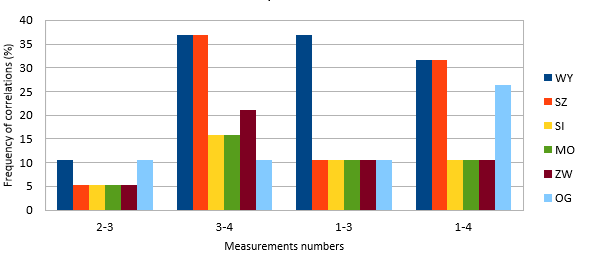
Figure 5: The frequency of significant correlations of physical fitness features with restitution of the posture features among 7-year-old boys n=30.
*Note: 2-3 Restitution of the values of body posture features after first minute of the load removal (between 2nd and 3rd measurement).
3-4 Restitution of the values of body posture features after second minute of the load removal (between 3rd and 4th measurement).
1-3 Restitution of the values of habitual posture features after first minute of the load removal (between 1st and 3rd measurement).
1-4 Restitution of the values of habitual posture features after second minute of the load removal (between 1st and 4th measurement).
WY - Endurance, SZ - Speed, SI - Strength, MO - Force, ZW - Agility, OG - Overall Fitness.
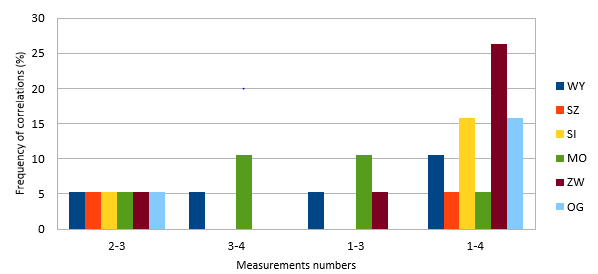
Figure 6: The frequency of significant physical fitness features with the restitution of the posture features among 7-year-old girls.
*Note: 2-3 Restitution of the values of body posture features after first minute of the load removal (between 2nd and 3rd measurement).
3-4 Restitution of the values of body posture features after second minute of the load removal (between 3rd and 4th measurement).
1-3 Restitution of the values of habitual posture features after first minute of the load removal (between 1st and 3rd measurement).
1-4 Restitution of the values of habitual posture features after second minute of the load removal (between 1st and 4th measurement).
SZ - Speed, SI - Strength, MO - Force, ZW - Agility, OG - Overall Fitness.
A detailed analysis of the boys’ results showed that the most frequent correlation with the restitution of the values of posture features in the first minute was endurance and overall fitness, and with the restitution in the second minute, endurance and speed. Among girls, all the tested features of fitness in the first minute, and endurance and power in the second were in correlation with restitution. The relationships in both cases were of low frequency. The analysis of restitution among boys, in terms of habitual posture features (first measurement) and the end of the first minute after the load removal (third measurement) showed that endurance was most often associated, and among girls it was force. The relationships were of a very low frequency. The analysis of restitution among boys, in terms of habitual posture features (first measurement) and the end of the second minute (fourth measurement) showed that the most frequently related were endurance and speed as well as overall fitness, and among girls it was agility. In general, the most frequent significant relationships between the restitution of posture features occurred with endurance and speed among boys, and with agility, strength and overall fitness among girls (Figures 5,6).
A detailed analysis of the boys’ results showed that in the posture features restitution with the tested fitness features in the first minute, the most frequent relationship was found in the asymmetry of the pelvis tilt to the left (KSM-) in the transversal plane, and among girls with asymmetry of the verticality of the torso, with a forward bend (KPT-). On the other hand, with the restitution in the second minute among boys, the asymmetry of the convexity of the lower angles of the shoulder blades, where the left angle is more convex (UB-), and the asymmetry of the pelvis tilt to the left (KSM- ) in the transversal plane. The correlations were sporadic and of low frequency among girls. The analysis of restitution among boys, in terms of habitual posture features (first measurement) and the end of the first minute after the load removal (third measurement) showed that the asymmetry of the convexity of the angles of the lower shoulder blades, where the left angle was more convex (UB- ) and the asymmetry of the pelvis tilt to the left (KSM-) in the transversal plane were the most frequently related to fitness features. Among girls, these relationships were sporadic and infrequent. The analysis of restitution among boys in terms of the habitual posture features (first measurement) and the end of the second minute (fourth measurement) showed that the most frequently related was the asymmetry of the convexity of the lower shoulder blade angles, where the left angle was more convex (UB-) and the asymmetry of the pelvis tilt to the left(KSM-) in the transversal plane and among girls it was the sum of partial angles (Delta), thoracic kyphosis (KKP) and lumbar lordosis (KLL).
Generally, among boys, the most common significant relationships between physical fitness and the restitution of the values of posture features occurred between the asymmetry of the convexity of the angles of the lower shoulder blades, where the left angle was more convex (UB-), and the asymmetry of the pelvis tilt to the left (KSM-) in the transversal plane, and among girls, it was between the asymmetry of the verticality of the torso flexion (KPT-) and the sum of partial angles (Delta), the angle of thoracic kyphosis (KKP) and the angle of lumbar lordosis (KLL) (Figures 7,8).

Figure 7: The frequency of significant physical fitness features with the restitution of the posture features among 7-year-old girls.
*Note: 2-3 Restitution of the values of body posture features after first minute of the load removal (between 2nd and 3rd measurement).
3-4 Restitution of the values of body posture features after second minute of the load removal (between 3rd and 4th measurement).
1-3 Restitution of the values of habitual posture features after first minute of the load removal (between 1st and 3rd measurement).
1-4 Restitution of the values of habitual posture features after second minute of the load removal (between 1st and 4th measurement).
SZ - Speed, SI - Strength, MO - Force, ZW - Agility, OG - Overall Fitness.
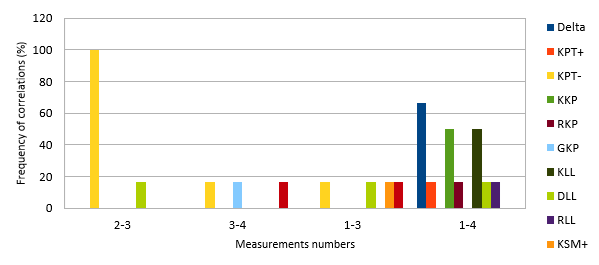
Figure 8: The frequency of significant correlations of the restitution of posture features with the physical fitness features year-old girls n=35. *Note: Description of abbreviations of body posture features - Table 1. 2-3 Restitution of the values of body posture features after first minute of the load removal (between 2nd and 3rd measurement). 3-4 Restitution of the values of body posture features after second minute of the load removal (between 3rd and 4th measurement). 1-3 Restitution of the values of habitual posture features after first minute of the load removal (between 1st and 3rd measurement). 1-4 Restitution of the values of habitual posture features after second minute of the load removal (between 1st and 4th measurement).
Conclusions
a) After removing the carried weight of school supplies from the chest, there was an incomplete restitution of almost all values of the diagnosed posture features after the first and second minutes.
b) The relationships between the examined determinants of physical fitness and the restitution of the values of posture features are much more frequent among boys than girls. Endurance and speed were the most common among boys, and agility, strength, and overall fitness among girls. Among boys, restitution of the values of posture features, which most often showed relationships with fitness features, were the asymmetry of the pelvis tilt to the left (KSM-) in the transversal plane, and the convexity of the lower angles of the shoulder blades, where the left one was more convex (UB-), and among girls, the asymmetry of verticality of the torso flexion (KPT-) in the sagittal plane, and the sum of the partial angles (Delta).
c) There should be actions taken to promote a healthy lifestyle for children, including physical education.
Acknowledgement
None.
Conflict of Interest
None.
References
- (2017) Report of the District Sanitary and Epidemiological Station in Ostrów Mazowiecka.
- Jakubowicz Bryx (2016) Hygiene of the teaching-learning process in the opinions of early childhood education students, Pedagogical Contexts. empirical research 1(6): 115-125.
- Bogdanowicz J (1962) Developmental properties of childhood. PZWL Warsaw.
- Hagner W, Bąk D, Hagner Derengowska M (2010) Changes in body posture in children in the first three years of school, Selected Clinical Problems. Via Medica.
- Annetts S, Coales P, Colville R, Mistry D, Moles K, et al. (2012) A pilot investigation into the effects of different office chairs on spinal angles. Eur Spine J (Suppl 2): 165-S170.
- Mrozkowiak M (2007) Biomechanical analysis of changes in selected dynamic parameters of feet during and after load = Biomechanical analysis of the changes in selected dynamic foot parameters in time and after load. Annales Universitatis Mariae Curie-Skłodowska, Sectio D: Medicina 62 Suppl 18 (5): 179-183.
- Mrozkowiak Mirosław, Sokołowski Marek, Kaiser Alicja (2016) An attempt to determine the effect of axial load on selected features of the body posture of fencers = An attempt to determine the effect of the axial load on selected posture fencers. Journal of Education, Health and Sport 6(10): 309-320.
- Mrozkowiak M (2007) Biomechanical analysis of changes in selected parameters of the pelvis-spine syndrome in the frontal and transverse plane during and after load. In: Education in a "risk" society. Safety as a value. 2 Edn. of Sciences. Matylda Gwoździcka-Piotrowska, Andrzej Zduniak. Poznań: Wydawnictwo Wyższa Szkoła Bezpieczeństwa: 339-342.
- Romanowska A (2009) Reaction of the child's spine - to the load of the school bag Physical and Health Education 4: 20-26.
- Bajorek W, Czarny P, Król M, Rzepko G, Sobo A, et al. (2011) Assessment of postural stability in traditional karate contestants. Journal of Combat Sports and Martial Arts 1(2) 2: 23-29.
- Barczyk Pawelec K, Giemza C (2012) The shape of anteroposterior curvature in the sagittal plane of girls practicing handball. Acta Bio-Optica et Informatica Medica, Biomedical Engineering 18(4): 237-242.
- Dolata Łubkowska W, Kruk J (1996) The influence of swimming sport on the formation of anteroposterior curvatures of the spine. Physical Education and Sport 2: 30-41.
- Drzał Grabiec J, Tryszczyńska A (2014) Evaluation of selected postural parameters in children who practice kyokushin karate, Biomedical Human Kinetics 6: 69-74.
- Grabara M (2009) Body posture of girls training sports gymnastics. Physical Education and Sport 53(4): 211-215.
- Grabara M, Hadzik A (2009) Body posture of girls training volleyball. Physical Education and Sport 53(4): 211-216.
- Słoniewski J, Łagan S (2010) Asymmetric posture defects within the shoulder girdle in the upper limbs in archery training players and ways to minimize them, Current Problems of Biomechanics.
- Ślężyński J, Rottermund J (1991) Somatic indicators, body posture and arch of volleyball players' foot. Physical Education and Sport 4: 59-65.
- Uetake T, Ohsuki F, Tanaka H, Shinto M (1998) The vertebral curvature of sportsmen. J Sport Sci 16: 621-628.
- Wojtków M, Korcz K, Szotek S (2009) The influence of sport shooting on the formation of body posture. Current Problems of Biomechanics.
- Zeyland Malawka E, Dębski J (1991) Anteroposterior shape, structural changes and pain in the spine and increased motor activity. Postępy Rehabilitacji 3: 47-55.
- Żurek G, Błach W, Ignasiak Z, Migasiewicz J (2005) Assessment of body posture of judo players in the light of the photogrammetric method using the Moir phenomenon. Medycyna Sportowa 21(4): 303-307.
- Mrozkowiak M (2015) Modulation, influence and relationships of selected posture parameters of children and adolescents aged 4 to 18 years in the light of projection moire, Kazimierz Wielki University Press, Bydgoszcz I, II.
- Sekita B (1988) Somatic development and physical fitness of children aged 3-7years. In () S Pilicz, Development of fitness and physical efficiency of children and adolescents - research reports. Warsaw.
- Osiński W, Antopomotoryka, AWF Poznań (2003).
- Mrozkowiak M, Kaiser A (2021) Physical Fitness in Preschool Children. Journal of Education, Health and Sport 11(11): 132-142.
- https://szczecinek.com/artykul/sprawny-jak-przedszkolak/654589.
- Mrozkowiak M (2021) Standardization of the diagnosis of body posture using photogrammetric methods MORA 4G HD. Physiotherapy Poland 1(21): 2-40.
- Mrozkowiak M, Thatched roof M (2012) Projection moult as a modern tool diagnostic posture = Projection moiré as a contemporary tool for body posture diagnostics Antropomotoryka. Kraków 22(60): 33-49.
- Mrozkowiak M (2020) How do parents perceive the schoolbag problem? Educators and Psychology of Sport 6(4): 151-162.
- Świerc A Computer diagnostics of body posture - instruction manual, CQ.
- Malinowski A, Wolański N (1988) Research methods in human biology, Selection anthropological methods, PWN, Warsaw 23-26.
- Kotarska K (2010) The level of physical Þ tness in children aged 4–6 years from Szczecin examined in one decade cycle, Scientific Journals of the University of Szczecin: 631.
- Wilgocka Okoń B (1972) School maturity and children's success in learning, Education in Kindergarten 1 Warsaw.
- Gniewkowska H (1967) Development of mobility of preschool children, Wychowanie w Przedszkolu 12 Warszawa.
- Mrozkowiak M (2020) An attempt to determine the difference in the impact of loading with the mass of school supplies carried using the left- and right-hand thrust on body Posture of 7-year-old pupils of both genders. Pedagogy and Psychology of Sport. 6(3): 44-71.
- Dobosz D, Sobota G (2011) Analysis of patterns of compensation of vertical body posture in children after being loaded with a school backpack, Current problems of Biomechanics 15: 19-24.
- Bitman F, Badke G (1988) Postural disorders of children and adolescents. Election0077anie Physical and School Hygiene 81.

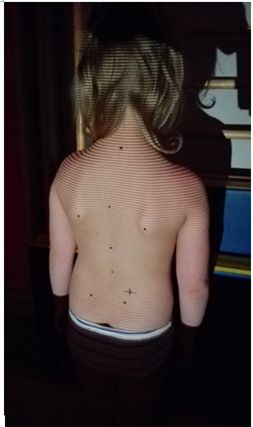
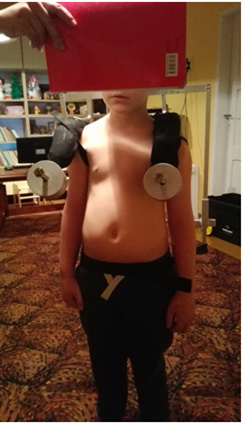
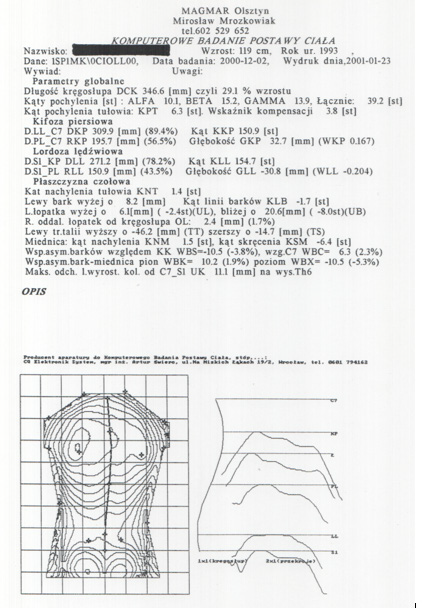

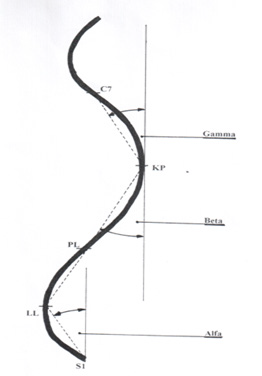
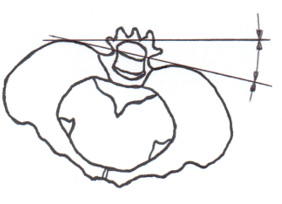

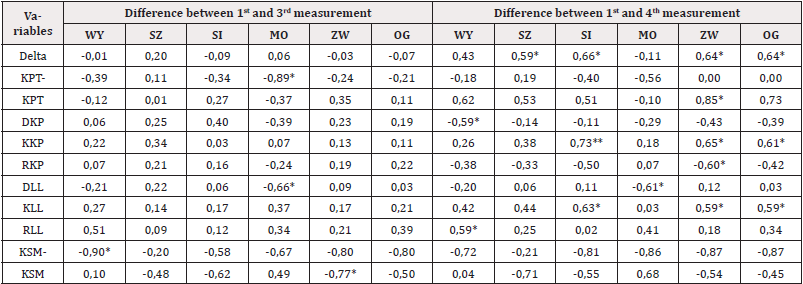


 We use cookies to ensure you get the best experience on our website.
We use cookies to ensure you get the best experience on our website.